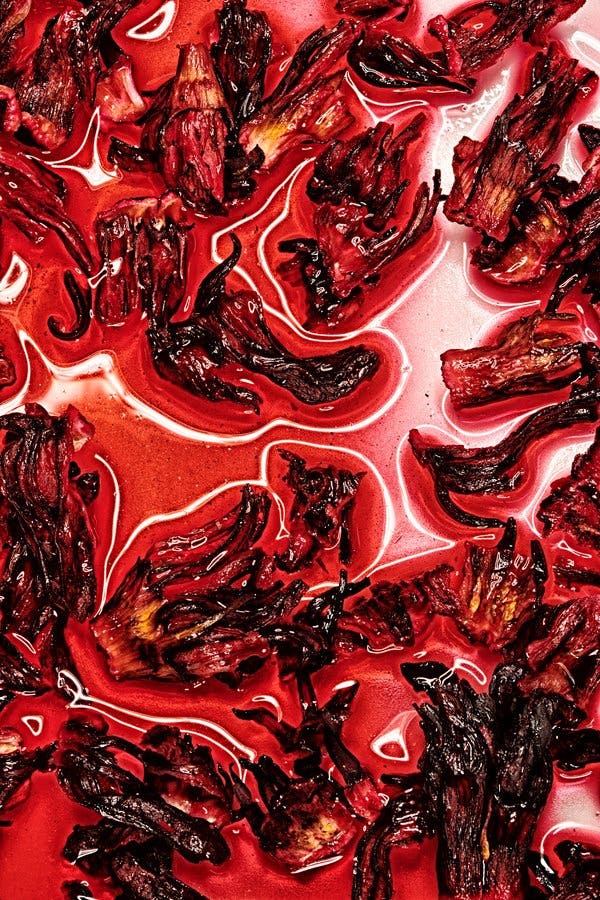At Super King, the Armenian-owned grocery chain with a hectic parking lot near my house in Los Angeles, I buy dried hibiscus flowers in bulk from a deep self-serve bin with a perpetually sticky-handled scoop. I say “flowers,” but in the kitchen, the bright red, sour wrinkles we call hibiscus aren’t really the flowers. We cook with the thick, protective covers of the Hibiscus sabdariffa — the tart red calyxes that shield its little buds, then stay on the plant even after the flowers have bloomed and fallen.
Also called roselle, red sorrel, sour-sour, flor de jamaica — every name for this hibiscus is a reminder that it has a place in kitchens around the world, in drinks and syrups and remedies and stews. The calyxes also happen to have a high pectin content, which once made them a favorite among the world’s jelly makers, though more recently, hibiscus has been pulled away from sweets and sugary jams and into the orbit of health foods (probably because in addition to its shocking, staining, hot pink color and phenolic antioxidants, it’s a source of vitamin C). It has also been marketed as a kind of meat replacement, because after the dried hibiscus is steeped in water and rehydrated, then sautéed in a little bit of fat, the fibers can soften, giving the hibiscus a gentle chew and the look of stewed meat.

CreditBobby Doherty for The New York Times. Food stylist: Maggie Ruggiero. Prop stylist: Margaret MacMillan Jones.
Adriana Almazán Lahl, who has a simple, delicious recipe for hibiscus quesadillas in the new cookbook “We Are La Cocina: Recipes in Pursuit of the American Dream,” reminded me that in Mexico, flowers came first — it was pork that was introduced by colonists. “Mexican cooking was mostly vegetarian for a long time,” said Lahl, the owner of Sal de Vida, a catering business in San Francisco. “We used to cook with a little fish, a lot of insects, but mostly vegetables, herbs and corn. Every region has different flowers that cooks work with now, and hibiscus is one of them.”
Lahl moved to California in 1994, to escape what she called the ghosts of her family. “Generation after generation, I saw women in Mexico didn’t have the same opportunities as men,” she said. “They held a lot of responsibilities, but the credit for their work always went to the men.” The ghosts Lahl saw were patterns repeating in her family, over and over, haunting her. “I had to be the one who broke the pattern,” she said. She left Mexico City, eager to start her own business, and began by selling infused finishing salts and packaged foods in San Francisco. After she wrote her first cookbook with Andrea Lawson Gray, “Celebraciones Mexicanas: History, Traditions and Recipes,” people started asking Lahl to cater their events, and her business grew.
To prepare hibiscus at home, and for parties, she steeps it in warm water for about five minutes and strains the water from the infusion. She mixes this with sugar and cinnamon and serves it on ice as a drink. Then she plays. “Not a lot of people cook the hibiscus itself, but every single ingredient in the Mexican kitchen is valuable,” Lahl said. At this point, the hibiscus still has some suppleness to it. It smells like simmering cranberry sauce. It’s full of promise. Lahl rinses it well to remove some of the excess sourness. And because the dehydrated calyxes tend to hide sand and grit in their creases, if you don’t rinse them well enough, you’ll meet the grit again when you bite into Lahl’s quesadillas.
That’s where Lahl tucks the sautéed flowers, folded inside crisp flour tortillas with lightly browned onions, serrano chiles and pieces of quesillo — the stringy Oaxacan cheese that melts beautifully and holds everything together. “Any cheese that melts well works,” Lahl said. “You can use Monterey Jack. You can use mozzarella.” When Lahl moved to San Francisco, she learned to improvise when she had to, in order to still make the dishes she loved — zucchini blossoms, huitlacoche and epazote weren’t easy to find. Neither were Mexican cheeses. Now she can find epazote, and she sometimes slips a few leaves into the hot pan with the hibiscus. “Get it nice and crispy, and flip,” she said. “That’s it. People are always so surprised at how good hibiscus can be, because people have been throwing it away.”
Recipe: Hibiscus Quesadillas




